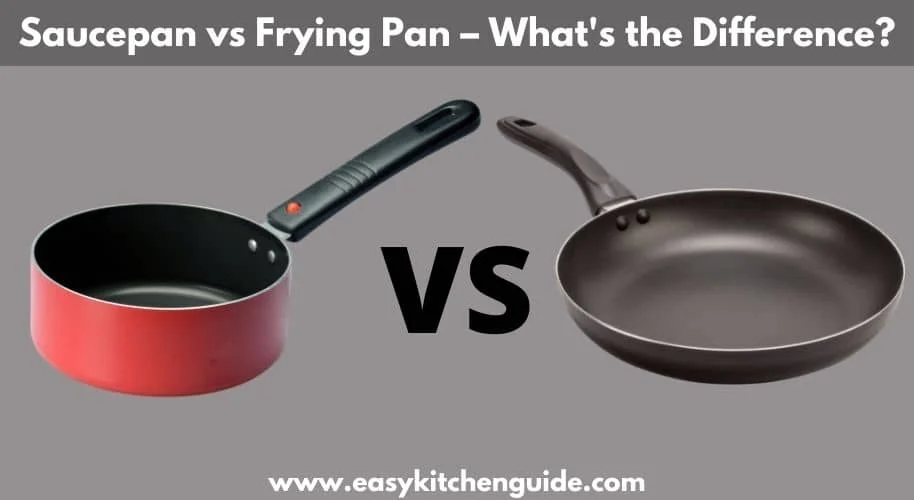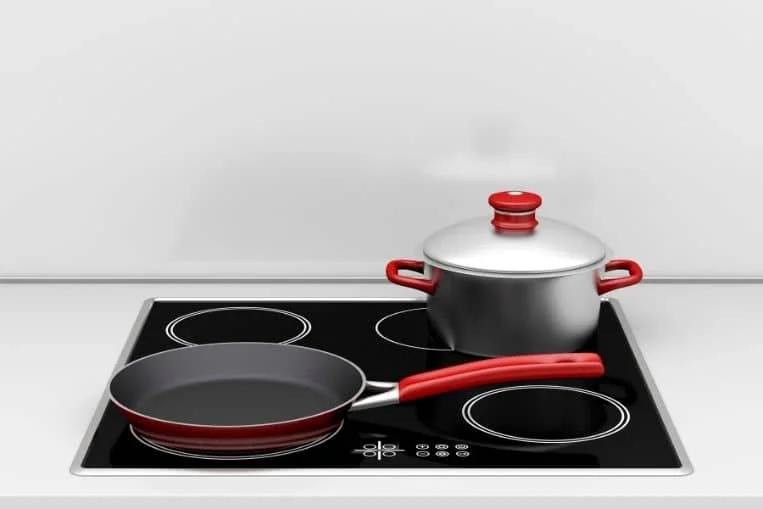When it comes to kitchen cookware, there are many different options to choose from. Two of the most popular types of cookware are saucepans and frying pans. But what’s the difference between them? And which one should you use for which type of cooking? In this blog post, we will discuss the differences between saucepans and frying pans, and teach you how to use them both effectively!

Saucepan
Saucepans are deep, round shapes and have a smaller surface area. They usually have a handle attached to one side. They are typically used for tasks such as simmering and boiling.
This means that saucepans are better for cooking food that needs to be stirred frequently, such as sauces and soups.
Saucepans are made from various materials, including metal, ceramic, and glass. They can be used on all types of cookers, including gas, electric, and induction hobs. Some saucepans even come with lids, which help to retain heat and prevent splatters.
Advantages of a saucepan:
– Saucepans are multipurpose. You can use them for boiling water, making soup, cooking pasta, and more.
-They have a long handle, making them easy to carry and transport, and also keep your hand away from the heat.
– Some saucepans come with a lid that helps to trap heat and moisture. It also helps to keep the sauce from splattering all over your stovetop.
-The smaller surface area means that heat is distributed more evenly, which is ideal for simmering and boiling.
– Their shape makes it easy to stir the contents.
-They are made of durable materials like stainless steel or aluminum.
Also Read: Can you use non stick pans on induction hob
Disadvantages of a saucepan:
-The deep shape can make it difficult to access food at the bottom.
-They are not always suitable for tasks such as frying or sautéing.
– Saucepans also have a tendency to be on the smaller side. This can be frustrating when you are trying to cook a large meal.
– They are difficult to clean. The narrow opening and the fact that they are often used for sticky or oily foods means that they can end up looking pretty grim after just a few uses.
Frying pan:
A frying pan is a type of pan used for frying. It is better for cooking food that needs to be flipped or tossed, such as pancakes or omelets. It is typically round, wide base, and has a handle attached to the side. Generally, most of them have flat bottoms. But there are also models with ridged or grooved bases.
A frying pan allows water in the pan to evaporate quickly so that food may be browned or seared. They are most commonly made from metals such as aluminum or stainless steel, but can also be made from other materials such as ceramic or cast iron.
Roasting pans come in a variety of sizes, from small ones that are only a few inches in diameter to large ones that are over a foot wide.
They also come in different shapes, and sizes of skillet such as oval or rectangular. Some frying pans even have multiple compartments so that you can cook several pieces of food at a time.
Advantages of a frying pan:
– Frying pans are versatile, durable, and affordable, making them a great option for anyone looking to equip their kitchen with the basics.
– They come in a range of sizes and materials, so you can find one that suits your needs perfectly.
– They heat up quickly and evenly.
– You can cook a variety of food in them.
– They’re easy to use and clean, which makes them ideal for busy cooks.
Disadvantages of a frying pan:
– Frying pans can also be dangerous if you’re not careful. If the oil is too hot, it can splatter and cause burns.
– If you don’t have the right oil or heat, your cooking dishes can stick to the pan and burn.
– Some non-stick frying pans might release toxic chemicals when heated.
– They can be difficult to store since they often don’t fit well in cabinets due to their larger sizes and long handles.
Also read: Deep frying in non stick pan
Cooking Purpose of Saucepan and Frying Pans

We’ve already mentioned above saucepans are most commonly used for sauces, soup, and boiling water while frying pans are used for frying chicken, meat, fish, and vegetables.
A saucepan heats up a high volume of liquid and keeps as much of it inside the pan as possible. So, if you are cooking sauce or soup without it evaporating too quickly, you’ll need a saucepan.
A frying pan, on the other hand, has sloped sides so that liquid can have rapid evaporation and food can be turned easily.
Frying pans come in all sorts of sizes, from small enough to fry one egg to large enough to fry a whole chicken.
Saucepans also come in different sizes, but they are generally taller and have straighter sides than frying pans.
So, when you’re trying to decide which pan to use for what purpose, think about how much liquid you’ll be working with and whether or not you need that liquid to evaporate quickly. If you do, then reach for the frying pan. If not, grab the saucepan.
Can You Use a Frying Pan as a Saucepan?
No, a frying pan is not suitable for use as a saucepan. It’s because you know that a saucepan has high, straight walls and a small surface area, which makes it ideal for cooking liquids and sauces.
Let’s assume you want to cook fish fry, chicken thighs, or vegetables in the saucepan. Due to the small surface area of the saucepan, you can’t arrange fish pieces on a whim and can’t toss them gently that result in an uneven cook.
The same applies to vegetables; you can’t roast or sauté them in a saucepan. So, in short, a saucepan is not at all suitable for cooking fry or veggies.
On the other hand, a frying pan has sloped sides, a flat cooking surface, and a large surface area. This design is perfect for cooking food that needs to be turned frequently or tossed, such as fish fillets, pancakes, and omelets.
Now, consider boiling water in a frying pan. The iron skillets or stainless steel skillets can’t hold much water in them due to their small sloped sides. Furthermore, boiling requires high heat that can damage the nonstick coating of your fry pan. So, it’s not advisable to use a frying pan as a saucepan.
So, what should you do if you don’t have a saucepan and need to cook something that requires one? In this case, it’s better to use a pot. A pot is similar to a saucepan but has slightly flared sides. This allows for even cooking of food and also makes it easier to stir.
Plus, a pot is usually larger than a saucepan, so you’ll be able to cook more food at once. So, if you don’t have a saucepan, go for a pot instead.
Wrapping up:
Thanks for reading the post on saucepan vs frying pan. We hope you found it helpful. Now you know the key differences between a saucepan and a frying pan as well as their cooking purpose. Use this knowledge to choose the right cookware for your next meal.
Do you need the top-quality non stick pans after reading this guide? Don’t worry, we’ve got you covered. We’ve reviewed the best non stick pan for gas stove. You can get some ideas by following the link. If you’re using an electric stove, you may read the following guide on the best frying pan for electric stove.
Do you have any questions or suggestions? Let us know in the comments below.
Sharing is caring!
My name is Lori Walker. I’m a registered dietitian, food blogger and food enthusiast. I share easy healthy, delicious recipes on my blog and review necessary kitchen items. The recipes I share take less… Read more
